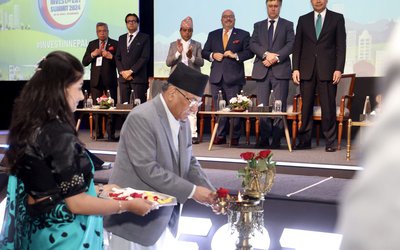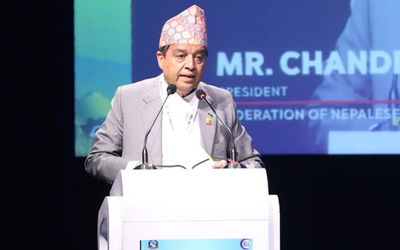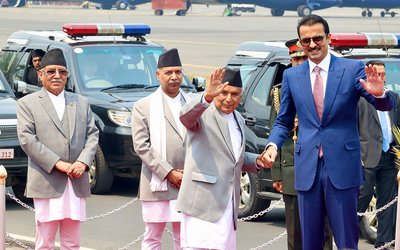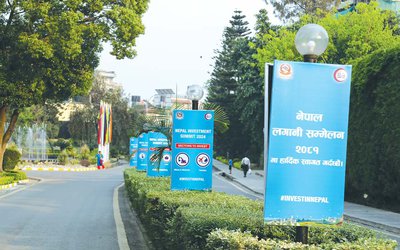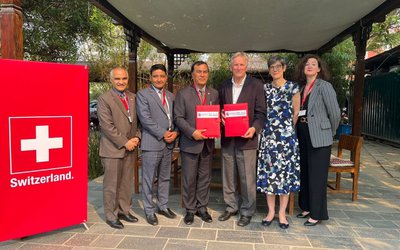Life of a rural subsistence farmer in Nepal is never easy and, right now, it’s about as hard as it gets, since the monsoon rains have had devastating impact on the crops and livelihoods across the country. Still not recovered from the brunt of 2015 earthquake, vulnerable households in Sindhupalchowk and Gokha have suffered massive losses due to heavy rain and landslides. People in Pyuthan, Kailali and few other districts also suffered major losses of human lives, livestock and properties. The weather unfortunately no longer seems to be following the normal trend and the current phenomenon of climate change seems to be aggravating the crisis in the country.
This cycle of disaster threatens thousands every year and the calamity is unfortunately recurring. Nepal in last few years has experienced significantly severe floods causing devastating impact on lives and livelihoods of thousands of families. Studies have revealed that the climate in Nepal is already changing, with higher temperatures and more inconsistent rainfall patterns, and it is going to be unfortunately no better in coming years.
According to official reports, as of April 2016, large number of people in Gorkha, Dhading, Rasuwa, Dolakha and Ramechhap remain highly food insecure, following the widespread devastation caused by the 2015 earthquake. In addition, authorities also indicate a significant deterioration of food security situation in remote areas, including Karnali region and Bajura district due to less cereal production and lower income from agriculture. Such situation puts these smallholders in more vulnerable situation to even minor external shocks.
The world is meanwhile also facing a dramatic increase in the frequency and scale of threats to food security and agriculture. Scientists have pointed out that natural disaster occurrences have increased and intensified significantly in the last 30 years due to the effects of climate change. Between 1994 and 2013, 6,873 natural disasters were recorded worldwide, which claimed 1.35 million lives and affecting 218 million people on average per annum during this 20-year period. Both slow and sudden onset disasters have been increasingly linked with displacements and outmigration as well. The needs are increasing every year, however resources have become much scarcer unfortunately.
The impact of the disasters can be however minimized if not completely avoided with better preparedness and resilience building, and minimizing the impact of disasters cost much lesser than what it takes to respond. The global community reaffirmed it by endorsing the 15-year Sendai Framework in 2015 calling for perseverance and persistence of actions to substantially reducing new and existing risks through people-centred, integrated and inclusive measures based on risk information.
The World Humanitarian Summit held in Istanbul in May 2016 has paved the way for bringing resources closer to the people. The so called Grand Bargain has emphasized on building resilience to safeguard the vulnerable communities affected by disasters, and for the already resilient smallholders in Nepal, it could be something much simpler and more accessible.
Putting the communities at risk in the driving seat should be the aim of better preparedness and resilience building. Preparedness actions such as better flood control measures for the communities at high risk of recurrent flooding would be an important step. Effective and low-cost solutions, such as afforestation and strengthening embankments, do already exist and can be effectively applied. Application of the early warning-early action system and use of satellite imagery to track weather patterns can allow local authorities and communities to take timely action. When meteorologists start forecasting heavy rains and floods, smallholders need access to information, means to protect lives and livelihoods against floods such as river control, access to safer places to move to; tarpaulins to protect themselves and their livestock, and bags to protect their stored grain and seeds.
UN Food and Agriculture Organization (FAO) has been working on strengthening people’s coping and adaptive capabilities through its early warning system and ample resilience building approach that can largely help people in Nepal cope better with crises. FAO’s strong global experience of quick resilience measures, such as animal feed, veterinary support, provision of crop and other livestock inputs to restart livelihoods and diversifying crops, and education would be a quick fix in the post-disaster phase to strengthen the resilience. Such actions will allow people to gain greater control over available resources, act quickly, and play a powerful role in recovering their disaster-affected livelihoods, which further helps strengthen their resilience and avoid outmigration. These are small demand-driven activities for the communities that can easily help address the second work stream of the Grand Bargain – how to bring resources closer to the local and national responders, and the sixth work stream – include people receiving aid in making the decisions which affect their lives in action.
Government of Nepal, with its existing information management system and wide communication network, is best placed to make its case at the international level for required financing for such interventions. The core commitments made at the Grand Bargain could be the leeway as the work stream two strongly commits to channeling at least 25% of the total global humanitarian financing to the local responders by 2020.
Aryal is a Senior Program Advisor for the global Food Security Cluster (FAO/WFP) Based in Rome, Italy.


